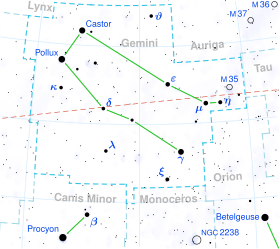
Back 81 Geminorum French 81 Geminorum ID 81 Geminorum Italian 81 Geminorum Portuguese 81 Близнецов Russian 81 Geminorum Swedish 81 เจมิโนรัม Thai 水位增四 Chinese
| Observation data Epoch J2000 Equinox J2000 | |
|---|---|
| Constellation | Gemini |
| Right ascension | 07h 46m 07.45014s[1] |
| Declination | +18° 30′ 36.0217″[1] |
| Apparent magnitude (V) | 4.89[2] |
| Characteristics | |
| Spectral type | K4 III[3] |
| B−V color index | 1.425±0.034[2] |
| Astrometry | |
| Radial velocity (Rv) | +83.13±0.08[2] km/s |
| Proper motion (μ) | RA: −79.687[1] mas/yr Dec.: −53.551[1] mas/yr |
| Parallax (π) | 9.1500 ± 0.2963 mas[1] |
| Distance | 360 ± 10 ly (109 ± 4 pc) |
| Absolute magnitude (MV) | −0.19[2] |
| Orbit[4] | |
| Period (P) | 1,519.7±1.7 d |
| Semi-major axis (a) | ≥ 142±3 Gm |
| Eccentricity (e) | 0.325±0.015 |
| Periastron epoch (T) | 41,584±11 MJD |
| Argument of periastron (ω) (secondary) | 73±3° |
| Semi-amplitude (K1) (primary) | 7.21±0.13 km/s |
| Details | |
| 81 Gem A | |
| Mass | 1.22[5] M☉ |
| Radius | 33.7+2.0 −1.7[1] R☉ |
| Luminosity | 287.3±10.5[1] L☉ |
| Surface gravity (log g) | 1.94[6] cgs |
| Temperature | 4,095+109 −115[1] K |
| Metallicity [Fe/H] | −0.18±0.06[2] dex |
| Age | 6.32[5] Gyr |
| Other designations | |
| Database references | |
| SIMBAD | data |
81 Geminorum is a binary star[8] system in the northern constellation of Gemini. It has the Bayer designation g Geminorum, while 81 Geminorum is its Flamsteed designation. This system is visible to the naked eye as a faint, orange-hued point of light with an apparent visual magnitude of 4.89.[2] The pair are located approximately 360 light years away from the Sun, based on parallax,[1] and are moving further away with a radial velocity of +83 km/s, having come to within an estimated 164 light-years of the Earth nearly a million years ago.[2] 81 Geminorum lies close enough to the ecliptic to undergo lunar occultations.[4][9]
The variable velocity of this system was first suspected at the Dominion Astrophysical Observatory in 1921, then confirmed by the Lick Observatory in 1922. It is a single-lined spectroscopic binary with an orbital period of 4.2 years and an eccentricity of 0.325.[4] The visible component is an aging giant star with a stellar classification of K4 III,[3] having exhausted the supply of hydrogen at its core then expanded to 34[1] times the Sun's radius. It is over six[5] billion years old with 1.22[5] times the mass of the Sun. This is a candidate alpha-enhanced star that displays a significant overabundance of silicon.[10] The star is radiating around 287[1] times the Sun's luminosity from its bloated photosphere at an effective temperature of 4,095 K.[1]
- ^ a b c d e f g h i j k l Cite error: The named reference
GaiaDR2was invoked but never defined (see the help page). - ^ a b c d e f g Cite error: The named reference
Anderson2012was invoked but never defined (see the help page). - ^ a b Cite error: The named reference
Keenan1989was invoked but never defined (see the help page). - ^ a b c Cite error: The named reference
Griffin1982was invoked but never defined (see the help page). - ^ a b c d Cite error: The named reference
luck2015was invoked but never defined (see the help page). - ^ Cite error: The named reference
Prugniel2011was invoked but never defined (see the help page). - ^ Cite error: The named reference
SIMBADwas invoked but never defined (see the help page). - ^ Cite error: The named reference
Eggleton2008was invoked but never defined (see the help page). - ^ Cite error: The named reference
Cassar1989was invoked but never defined (see the help page). - ^ Cite error: The named reference
Franchini2004was invoked but never defined (see the help page).
